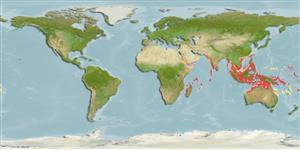Environment: milieu / climate zone / depth range / distribution range
Écologie
marin récifal; non migrateur; profondeur 1 - 60 m (Ref. 90102). Tropical; 25°N - 25°S
Indo-West Pacific: East coast of Africa, throughout Indonesia and New Guinea to New Caledonia, north to southern Japan.
Taille / Poids / Âge
Maturity: Lm ? range ? - ? cm
Max length : 45.0 cm TL mâle / non sexé; (Ref. 9710)
Épines dorsales (Total) : 13; Rayons mous dorsaux (Total) : 20 - 21; Épines anales: 3; Rayons mous anaux: 20.
Inhabits coastal reefs to at least 30 m (Ref. 9710). Adults often found in pairs inside caves (Ref. 9710, 48636). Juveniles settle in very shallow inshore habitats with short filamentous algae growth on rock or dead coral substrates (Ref. 48636). Feeds on sponges and tunicates (Ref. 48391). Undergoes a complete color transformation from the juvenile to adult stage. Regularly exported, e.g. from Sri Lanka, for the aquarium trade.
Life cycle and mating behavior
Maturité | Reproduction | Frai | Œufs | Fécondité | Larves
Steene, R.C., 1978. Butterfly and angelfishes of the world. A.H. & A.W. Reed Pty Ltd., Australia. vol. 1. 144 p. (Ref. 4859)
Statut dans la liste rouge de l'IUCN (Ref. 130435: Version 2024-1)
Menace pour l'homme
Harmless
Utilisations par l'homme
Pêcheries: sans intérêt; Aquarium: Commercial
Outils
Articles particuliers
Télécharger en XML
Sources Internet
Estimates based on models
Preferred temperature (Ref.
123201): 26.3 - 29.1, mean 28.3 °C (based on 1202 cells).
Phylogenetic diversity index (Ref.
82804): PD
50 = 0.5001 [Uniqueness, from 0.5 = low to 2.0 = high].
Bayesian length-weight: a=0.03236 (0.01318 - 0.07944), b=2.88 (2.70 - 3.06), in cm total length, based on LWR estimates for this Genus-body shape (Ref.
93245).
Niveau trophique (Ref.
69278): 2.6 ±0.00 se; based on food items.
Résilience (Ref.
120179): Faible, temps minimum de doublement de population : 4,5 à 14 années (Preliminary K or Fecundity.).
Fishing Vulnerability (Ref.
59153): Low to moderate vulnerability (35 of 100).
Nutrients (Ref.
124155): Calcium = 38.1 [18.7, 64.7] mg/100g; Iron = 0.502 [0.301, 0.834] mg/100g; Protein = 18.2 [16.9, 19.4] %; Omega3 = 0.0899 [, ] g/100g; Selenium = 37.8 [19.9, 73.4] μg/100g; VitaminA = 54.3 [13.1, 209.4] μg/100g; Zinc = 1.29 [0.89, 1.85] mg/100g (wet weight);
